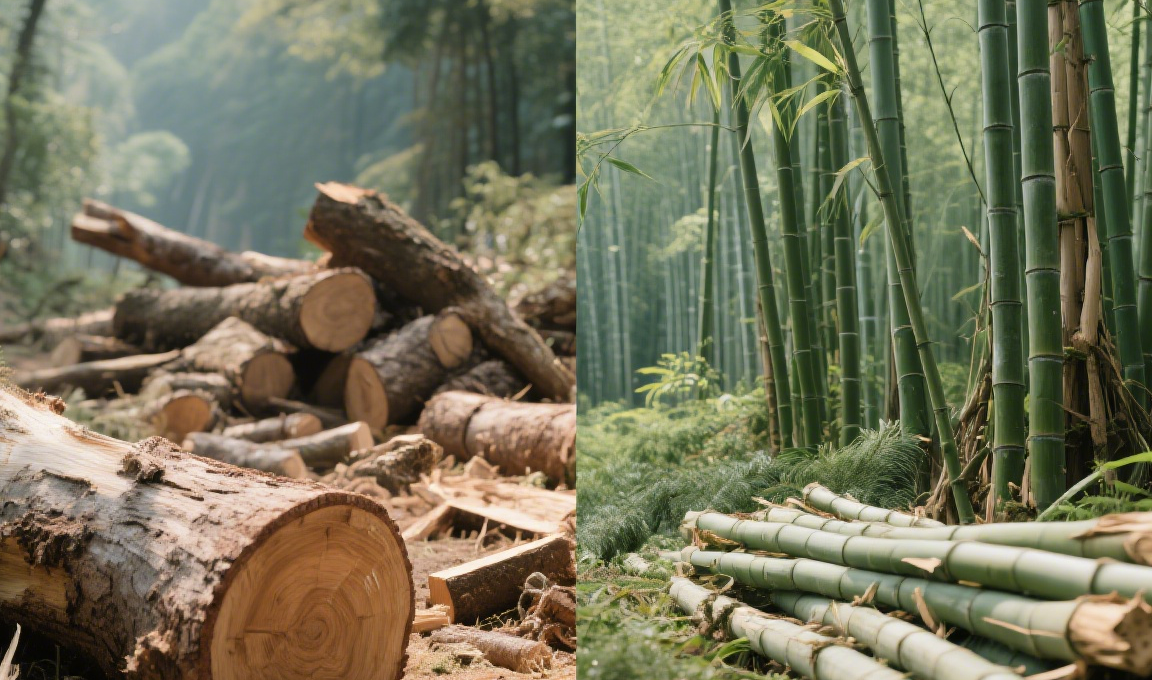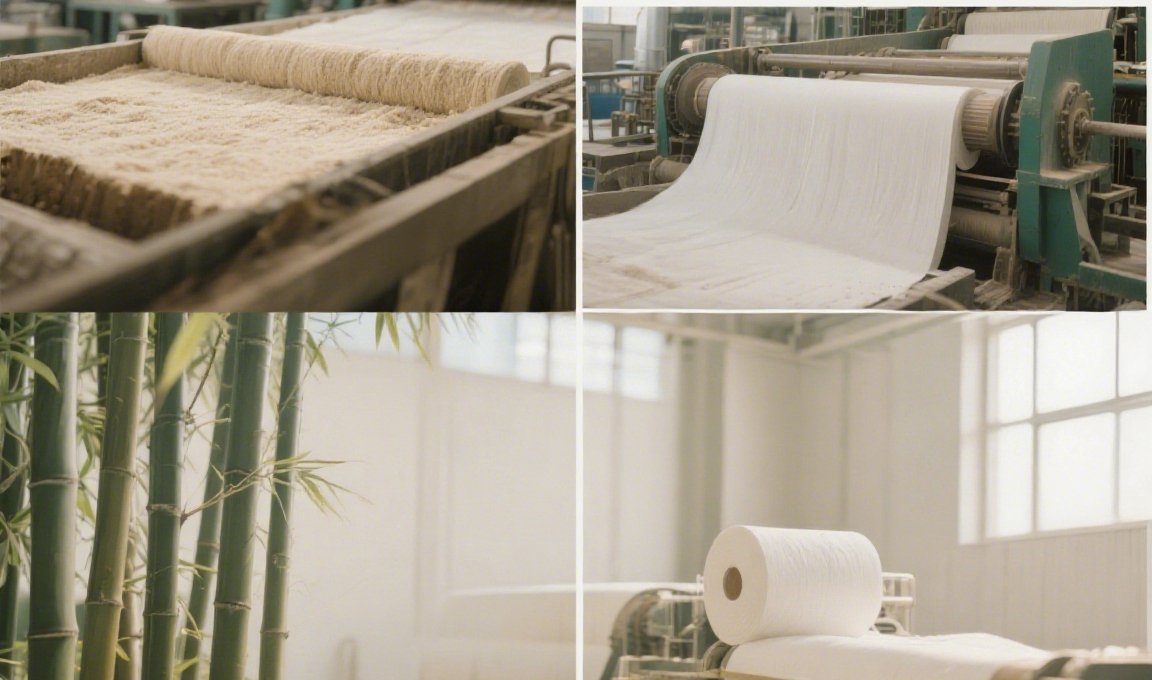close
Choose Your Site
Global
Social Media
Views: 0 Author: Site Editor Publish Time: 2025-07-08 Origin: Site
Did you know that one tree produces just 800–1,000 toilet rolls—and takes 30 years to grow—while bamboo regenerates in 2–3 years and yields 35x more oxygen? As forests shrink and sustainability becomes urgent, the tissue industry faces a critical choice: stick with traditional virgin wood pulp or switch to fast-growing bamboo pulp. This decision impacts everything from your skin’s comfort to our planet’s future.
Here’s the problem: brands and consumers need tissue paper that balances softness, strength, and eco-friendliness—but misinformation about raw materials like virgin wood pulp and bamboo pulp clouds the debate. While wood pulp dominates shelves, bamboo’s natural antibacterial power (thanks to “Bamboo Kun”) and 30% lower production energy make it a rising star. And for manufacturers sourcing parent rolls (the jumbo bases for converted tissues), picking the right pulp affects costs, certifications, and even septic safety.
In this post, you’ll learn:
1. Why raw materials define performance: How wood pulp’s fiber length battles bamboo’s breathability in real-life tests like wet-rub durability and dust-resistance.
2. The sustainability showdown: Bamboo’s role in saving 0.5m² of forest per box versus FSC-certified wood pulp.
3. Parent roll pro tips: Grammage ranges (28–35g/m² for toilet paper), septic-safe certifications, and how to avoid whitening chemicals.

Sources: Harvested from hardwood trees (eucalyptus, oak) or softwood trees (pine, spruce) through forest logging.
Environmental Impact:
High deforestation footprint: One tree yields only 800–1,000 toilet rolls, and trees require 10–30 years to mature before harvest.
Resource-intensive: Production relies on clearcutting forests, contributing to habitat loss and soil erosion. FSC certification mitigates this but doesn’t eliminate the slow regeneration cycle.
Common Uses: Ideal for premium toilet paper and facial tissues where ultra-softness is prioritized.
Sources: Sourced from fast-growing bamboo species (e.g., Ci Bamboo in Sichuan, China), harvested in just 2–3 years without killing the plant (regrows from roots).
Sustainability Advantages:
Zero deforestation: As a grass, bamboo grows 30x faster than trees and requires no replanting.
Superior eco-output: Produces 35x more oxygen and sequesters more carbon than tree forests.
️ Resource efficiency: One box of bamboo paper saves 0.5m² of forest land.
Natural antibacterial protection: Contains “Bamboo Kun”, inhibiting bacteria like E. coli—no synthetic chemicals needed.
Ideal For:
Eco-focused brands seeking biodegradable, plastic-free options.
Septic-safe toilet paper due to rapid decomposition (avoids pipe clogs).
| Factor | Virgin Wood Pulp | Bamboo Pulp |
|---|---|---|
| Growth Cycle | 10–30 years | 2–3 years |
| Oxygen Production | Baseline | 35x higher |
| Land Conservation | None | 0.5m² forest/box saved |
| Antibacterial Traits | None (requires additives) | Natural (Bamboo Kun) |

Softwood vs. Hardwood:
Softwood (e.g., pine): Long fibers create strong interweaving bonds, resulting in high tensile strength and durability—ideal for toilet paper needing wet strength.
Hardwood (e.g., oak): Short fibers form a smoother surface, reducing skin friction and making it perfect for ultra-soft facial tissues.
Performance in Tissue:
High wet tensile strength (≥90N/m): Resists tearing when wet, outperforming many recycled pulps.
Low dust residue: Minimal shedding during processing ensures cleaner production lines and reduced user inhalation risks.
Wood Pulp Fiber Comparison
| Fiber Type | Length | Key Strength | Best For |
|---|---|---|---|
| Softwood | Long | High tear resistance | Toilet paper, towels |
| Hardwood | Short | Smooth surface | Facial tissues, napkins |
Natural “Bamboo Kun”:
An antibacterial agent that inhibits E. coli and Staphylococcus aureus growth within 24 hours, reducing infection risks in hygiene products.
Structural Superiority:
Hollow fiber cross-section: Provides 3.5x better breathability than cotton, enhancing comfort in tissues.
Medium-length fibers: Balances softness (like hardwood) and tear resistance (like softwood), making it versatile for all tissue types.
Parent Roll Benefits:
Higher bulk: Fewer layers achieve the same thickness (e.g., 3-ply bamboo = 4-ply wood pulp), saving material costs.
Low-lint & high absorption: Ideal for kitchen towels, absorbing 3x its weight in oil/water without disintegrating.
Bamboo Fiber Advantages
| Property | Impact on Tissue Performance |
|---|---|
| Hollow Structure | Faster drying, better airflow (reduces skin irritation) |
| Bamboo Kun | Natural bacteria resistance (no chemical additives needed) |
| Medium Fiber Length | Soft yet durable—fewer plys needed for strength |
Practical Performance Comparison
| Test | Virgin Wood Pulp | Bamboo Pulp |
|---|---|---|
| Wet Strength | 90N/m (softwood) | 120N/m (superior durability) |
| Dust After Kneading | Low | Very low (1/5 of wood pulp) |
| Layers for 40g/m² | 4-ply | 3-ply |

Steps:
Debarking & Chipping: Logs are stripped of bark and cut into small chips using disc/drum chippers.
Chemical Pulping: Chips are “cooked” in digesters with chemicals (e.g., Kraft process) to dissolve lignin and extract cellulose fibers.
Bleaching: Pulp is treated with chlorine or chlorine dioxide to whiten, risking dioxin pollution if unmanaged
Drying & Creping: Pulp is dried, pressed into sheets, and creped (scraped) to create soft, textured tissue paper.
Key Concerns:
High Pollution Risk: Chlorine bleaching releases toxic dioxins, requiring strict wastewater treatment.
Resource Intensity: Uses 10–15m³ water per ton of pulp and high energy for cooking/drying.
Deforestation Link: Relies on slow-growing trees (10–30 years), worsening habitat loss
Eco-Tech Focus:
Chlorine-Free Bleaching: Uses hydrogen peroxide or ozone to whiten pulp, eliminating toxic byproducts.
Zero-Whitening: Retains natural pale-yellow hue, avoiding synthetic fluorescent agents.
Gentle Fiber Extraction: Combines steam explosion and alkaline treatments to preserve fiber integrity without harsh chemicals.
Efficiency Advantages:
30% Lower Energy: Bamboo’s softer fibers reduce pulping energy vs. wood[.
Closed-Loop Water Systems: Recycles >80% of water during washing/screening.
Rapid Renewability: Harvested in 2–3 years (vs. decades for trees), cutting supply chain emissions.
| Phase | Virgin Wood Pulp | Bamboo Pulp |
|---|---|---|
| Raw Prep | Chipping debarked logs | Steam explosion to soften fibers |
| Pulping | Kraft chemical cooking (70–170°C) | Alkaline/mechanical digestion (milder temps) |
| Bleaching | Chlorine-based (dioxin risk) | H₂O₂/O₃ (non-toxic) |
| Water Usage | 10–15m³/ton | 5–8m³/ton (recycled) |
| Energy Demand | High (drying/creping-intensive) | 30% lower |
Parent Roll Quality Checks:
✅ Bamboo “Kun” Retention: Antibacterial properties preserved via low-temperature drying.
✅ Dust Control: Mechanical screening removes >95% of fines before creping.
FSC (Forest Stewardship Council):
Ensures wood comes from responsibly managed forests that protect biodiversity and Indigenous rights.
Only 61% of managed forests currently meet this standard, limiting supply for certified wood pulp.
Critical for brands targeting eco-conscious buyers, though carbon footprint remains high (1.3 tCO₂e/tonne).
FDA Compliance:
Validates safety for infant oral contact (e.g., pacifier wipes), requiring zero fluorescent agents or fragrances.
EU AP (Food Grade):
Permits direct food wrapping (e.g., bamboo kitchen towels absorbing oil from fried foods).
Biodegradable Certification:
Confirms 100% septic-safe decomposition, preventing pipe clogs—key for toilet paper brands.
Sustainability Edge: Bamboo pulp uses 30% less energy in production and saves 0.5m² of forest per box.
| Market | Demand Drivers |
|---|---|
| Hotels | Ultra-softness (hardwood pulp) for facial tissues; FSC certification for eco-image. |
| Healthcare | High wet strength (≥90N/m) for medical wipes; low dust to reduce respiratory risks. |
Eco-Conscious Households:
30% YoY market growth driven by carbon footprint (0.8 tCO₂e/tonne) and antibacterial “Bamboo Kun”.
Sensitive-Skin Users:
Hypoallergenic traits: Natural antibacterial properties reduce rashes; no chemical additives.
Fragrance-free: Ideal for baby wipes and facial tissues, with FDA/oral-contact compliance.
| Factor | Wood Pulp Tissues | Bamboo Pulp Tissues |
|---|---|---|
| Price Premium | 20–30% (luxury hotels/healthcare) | 10–15% (eco-households) |
| Key Certification | FSC (supply-limited) | FDA/EU AP (broader accessibility) |
| Consumer Appeal | Softness, strength | Sustainability, skin safety |
| Growth (CAGR) | 3.8% (2023–2030) | 11.2% (2023–2030) |
Virgin Wood Pulp:
Higher cost due to scarcity of mature trees (10–30 years growth) and limited FSC-certified supply.
Ideal for: Brands prioritizing softness over budget (e.g., luxury facial tissues).
Bamboo Pulp:
✅ Lower long-term cost: 30% cheaper than softwood pulp, with higher yield per acre (1 bamboo forest = 35x output of tree forest).
Ideal for: High-volume production (e.g., bulk toilet paper rolls).
| Factor | Virgin Wood Pulp | Bamboo Pulp |
|---|---|---|
| Wet Strength | 90N/m (softwood) → Good for facial tissues | 120N/m → Superior for kitchen towels & wet wipes |
| Flexibility | Short hardwood fibers = smoother finish | Hollow fibers = 3.5x better airflow & tear resistance |
| Layers Needed | 4-ply for 40g/m² thickness | 3-ply achieves same bulk (reduces material use) |
Virgin Wood Pulp:
Moderate score if FSC-certified: Protects forests but still requires 10x more land and emits 1.3 tCO₂e/tonne.
Bamboo Pulp:
Zero deforestation (regrows in 2–3 years).
Saves 0.5m² forest/box and uses 30% less energy.
Biodegradable & septic-safe (dissolves 40% faster than wood pulp).
High sustainability:
| Tissue Type | Top Pulp Choice | Why? |
|---|---|---|
| Facial Tissues | Virgin Wood Pulp (hardwood) | Short fibers = ultra-soft texture; FSC certification appeals to hotels. |
| Kitchen Towels | Bamboo Pulp | High oil/water absorption (3x weight); antibacterial for food safety. |
| Toilet Rolls | Bamboo Pulp | Septic-safe decomposition; 120N/m wet strength prevents clogs. |
Wet-Rub Test:
Bamboo: Stays intact (hollow fibers resist fraying).
Wood pulp: May fray if low-grade or recycled.
Rub saturated tissue 10x:
Grammage Check:
Toilet paper: 28–35g/m²
Kitchen rolls: >40g/m² (e.g., Kangbeibao’s 3x oil-absorbent towels).
Use a grammage scale:
Dust Test:
High-quality pulps leave <5% residue .
Knead dry tissue 5x:
Virgin wood pulp remains unbeaten for ultra-soft, strong tissues—especially in facial and premium toilet rolls. Our products leverage hardwood pulp’s smoothness (perfect for sensitive skin) and softwood’s 90N/m wet strength.
With FSC-certified sourcing and chlorine-free bleaching, we meet strict sustainability demands. Innovations like water-saving tech and plastic-free packaging keep us ahead.
Brands trust virgin wood pulp for luxury performance—no compromises.